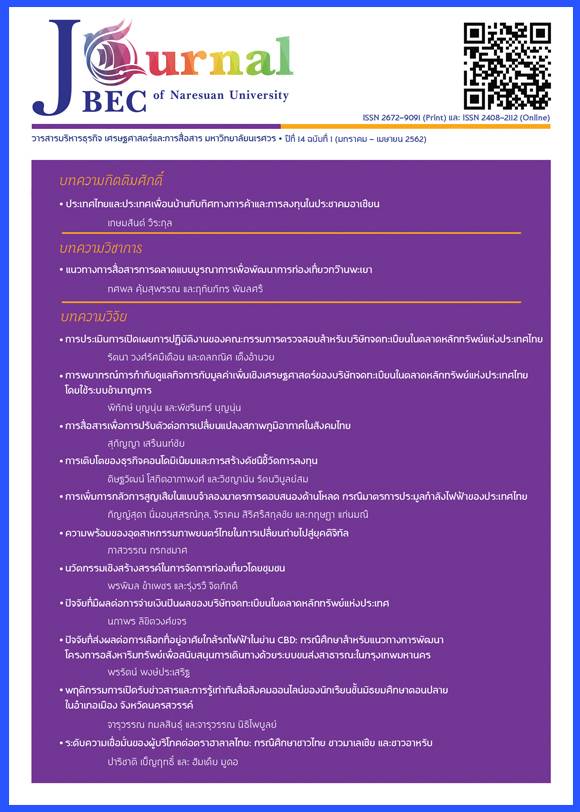ปัจจัยที่ส่งผลต่อการเลือกที่อยู่อาศัยใกล้รถไฟฟ้าในย่าน CBD: กรณีศึกษาสำหรับแนวทางการพัฒนาโครงการอสังหาริมทรัพย์เพื่อสนับสนุนการเดินทางด้วยระบบขนส่งสาธารณะในกรุงเทพมหานคร
Main Article Content
บทคัดย่อ
งานวิจัยนี้ช่วยให้เข้าใจปัจจัยที่มีผลต่อการเลือกพักอาศัยใกล้สถานีรถไฟฟ้าในรัศมี 1 กิโลเมตร ในพื้นที่ศูนย์กลางธุรกิจ (Central Business District: CBD) ซึ่งในพื้นที่นี้ ราคาขายที่ดินและอสังหาริมทรัพย์เติบโตสูงขึ้นอย่างต่อเนื่อง ผลของความไม่สมดุลกันระหว่างการจ้างงานและที่อยู่อาศัยไม่ส่งผลดีต่อการเติบโตของการพัฒนาเศรษฐกิจในเมืองอัดแน่นรอบสถานี ตามแนวทางการพัฒนาพื้นที่รอบสถานีขนส่ง (Transit-Oriented Development: TOD) งานวิจัยนี้ต้องการให้นักพัฒนาอสังหาริมทรัพย์ได้เข้าใจลักษณะกลุ่มผู้ที่อยู่อาศัยใกล้สถานีรถไฟฟ้าในปัจจุบัน เพื่อนำไปพัฒนาโครงการที่อยู่อาศัยให้ตรงความต้องการของผู้ที่อยู่อาศัยจริง สำหรับนักวางแผนเมือง ได้เข้าใจถึงปัญหาการวางแผนเมือง โดยเฉพาะการขาดการพัฒนาที่พักอาศัยสำหรับผู้มีรายได้น้อยใกล้สถานีรถไฟฟ้า งานวิจัยนี้เก็บข้อมูลด้วยการทำแบบสอบถามกับผู้อยู่อาศัยใกล้สถานีรถไฟฟ้าในรัศมี 1 กิโลเมตร จำนวน 427 คน จากผลการศึกษา สามารถสรุปลักษณะของกลุ่มผู้ที่อาศัยใกล้สถานีรถไฟฟ้าในย่าน CBD และ Non-CBD และปัจจัยที่มีผลต่อการเลือกซื้อที่อยู่อาศัยใกล้สถานีรถไฟฟ้าในย่าน CBD โดยใช้การวิเคราะห์แบบจำลองถดถอยโลจิสติกส์ โดยพบว่า ปัจจัยด้านสถานะ, อายุ, รายได้, ตำแหน่งสถานที่ทำงาน และพฤติกรรมการเดินทาง มีอิทธิพลต่อการเลือกซื้อที่อยู่อาศัยใกล้รถไฟฟ้าในย่าน CBD
Article Details
References
2. Bangkok Metropolitan Administration (BMA). (2006). The Bangkok comprehensive plan 2006. Retrieved June 10, 2018, from https://www.bma-cpd.go.th/files/001/DefineCompre54.pdf
3. Bhat, C. R. and Guo, J. Y. (2007). A comprehensive analysis of built environment characteristics on household residential choice and auto ownership levels. Transportation Research Part B: Methodological, 41(5), 506-526.
4. Carlstein, T., Parks, D. and Thrift, N. (eds.) (1978). Timing space and spacing time. Vol. 1: Making sense of time. Vol. 2: Human activity and time geography. Vol. 3: Time and regional dynamics. London: Edward Arnold.
5. Calthorpe, P. (1993). The next American metropolis ecology, community and the American dream. New York: Princeton Architectural Press.
6. CBRE. (2017). Highest land price of 3 areas in Bangkok CBD. Retrieved June 8, 2018, from https://www.cbre.co.th/propertynews/land-investment-p15878/
7. Chalermpong. S. and Ratanawaraha, A. (July 15-18, 2013). Travel behavior of residents of condominiums of near Bangkok’s rail transit stations. In 13th World Conference on Transport Research (pp. 1-13). Rio de Janeiro, Brazil.
8. Freedman, O. and Kern, C. R. (1997). Model of workplace and residential choice in two-worker households. Regional Science and Urban Economics, 27(3), 241-260.
9. Kaiyawan, Y. (2014). Multivariate statistical analysis for research. Bangkok: Chulalongkorn University Publishing.
10. Knight Frank. (2015). Research, Q2 2015 Bangkok office market. Retrieved June 9, 2018, from www.content.knightfrank.com/ research/361/documents/en/q2-2015-bangkok-office-market-3079.pdf
11. Lee, B. H. Y. and Waddell, P. A. (2010). Residential mobility and location choice: A nested logit model with sampling of alternatives. Transportation, 37(4), 587-601.
12. Lee, K. I., Kim, K. J. and Kwon, S. J. (2005). A study on characteristics of subway utilization and pedestrians’ accessibility at new town in Korea. Journal of Asian Architecture and Building Engineering, 4(1), 85-95.
13. Malaitham, S., Kanagawa, D., Matsunaka, R., Yoon, J. and Oba, T. (2013). An analysis of residential location choice behavior in Bangkok Metropolitan Region: An application of discrete choice models for the ranking of alternatives. Journal of the Eastern Asia Society for Transportation Studies (EASTS), 10, 989-1008.
14. Mitchell, C. G. B. and Stokes, R. G. F. (1982). Walking as a mode transport, TRRL laboratory report 1064, transport and road research laboratory, department of the environment. U.K.: Department of Transport.
15. Office of Transport and Traffic Policy and Planning (OTP). (2015). A report of developing the transit modeling in Bangkok. Retrieved June 8, 2018, from https://www.otp.go.th/ index.php/edureport/
16. Peduzzi, P., Concato, J., Kemper E., Holford, T. R. and Feinstein, A. R. (1996). A simulation study of the number of events per variable in logistic regression analysis. Journal of Clinical Epidemiology, 49(12), 1372-1379.
17. Pongprasert, P. (2015). The guidelines for transit-oriented development (TOD) in Thailand. Ladkrabang Engineering Journal, 32(1), 7-12.
18. Pongprasert, P. and Kubota, H. (2017a). Factor affecting residents living near transit stations to use transit: Case study about daily travel in Bangkok, Thailand. Journal of the Eastern Asia Society for Transportation Studies (EASTS), 12, 854-873.
19. Pongprasert, P. and Kubota, H. (2017b). Why TOD residents still use car? Understanding the factors affecting the automobile ownership and use of residents living near transit stations of Bangkok. Urban and Regional Planning Review (URPR), 4, 231-250.
20. Pongprasert, P. and Kubota, H. (2017c). Switching from motorcycle taxi to walking: A case study of transit station access in Bangkok, Thailand, Journal of International Association of Traffic and Safety Science (IATSS) Research, 41(4), 182-190.
21. Pongprasert, P. and Kubota, H. (July 15-18, 2018). The influences of built environment factors on mode switching of TOD residents from car use to transit dependence: Case study of Bangkok, Thailand. In American Society of Civil Engineering (ASCE) International Conference on Transportation and Development (ICTD 2018) (pp. 186-197). Pennsylvania, United State.
22. Posttoday. (2011). New generation needs condominium in urban area. Retrieved June 10, 2018, from https://www.posttoday.com/property/news/107845
23. Rastogi, R., Krishna Rao, K. V. (2003). Travel characteristics of commuter accessing transit: Case study. Journal of Transportation Engineering, 129(6), 684-694.
24. Rood, T. (2001). Ped sheds, transportation tech sheet, congress for the New Urbanism, USA. Retrieved June 10, 2018, from https://www.cnu.org/publicsquare/
25. Sangkakoon, P. and Ngarmyarn, A. (2017). Factors that affect the intention to buy a family home. Journal of Business, Economics and Communications, 12(2), 145-160.
26. Stringham, M. (1982). Travel behavior associated with land uses adjacent to rapid transit stations. Institute of Transportation Engineers Journal, 52(4), 16-18.
27. Tanaviboonchai, S. (2016). Influential factors for purchasing condominium along skytrain and subway lines in Bangkok and its vicinity. Independent study, M.S., Thammasat University, Bangkok.
28. Thailand Marketing Research Soceity (TMRS). (2015). Income level classification of people living in Bangkok. Retrieved June 10, 2018, from https://www.marketingoops.com/ reports/research/hakuhodo-research-middle-class-asean/
29. Urban Design and Development Center (UDDC). (2017). Jobs-housing unbalance in Bangkok city. Retrieved June 5, 2018, from https://www.uddc.net/th/knowledge/jobs-housing-unbalance
30. Vuchic, V. R. (2005). Urban transit, operations, planning and economics. New Jersey: John Wiley and Sons.
31. Waddell, P. (October, 1996) Accessibility and residential location: the interaction of workplace, residential mobility, tenure and location choices. In TRED Conference on Land Use and Transportation (pp. 1-24). Lincoln Institute of Land Policy, Cambridge, Massachusetts, USA.

